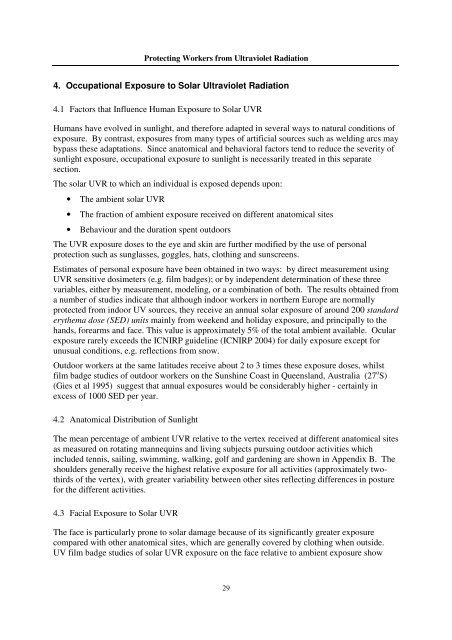Protecting Workers from Ultraviolet Radiation - icnirp
Protecting Workers from Ultraviolet Radiation - icnirp
Protecting Workers from Ultraviolet Radiation - icnirp
Create successful ePaper yourself
Turn your PDF publications into a flip-book with our unique Google optimized e-Paper software.
<strong>Protecting</strong> <strong>Workers</strong> <strong>from</strong> <strong>Ultraviolet</strong> <strong>Radiation</strong><br />
4. Occupational Exposure to Solar <strong>Ultraviolet</strong> <strong>Radiation</strong><br />
4.1 Factors that Influence Human Exposure to Solar UVR<br />
Humans have evolved in sunlight, and therefore adapted in several ways to natural conditions of<br />
exposure. By contrast, exposures <strong>from</strong> many types of artificial sources such as welding arcs may<br />
bypass these adaptations. Since anatomical and behavioral factors tend to reduce the severity of<br />
sunlight exposure, occupational exposure to sunlight is necessarily treated in this separate<br />
section.<br />
The solar UVR to which an individual is exposed depends upon:<br />
• The ambient solar UVR<br />
• The fraction of ambient exposure received on different anatomical sites<br />
• Behaviour and the duration spent outdoors<br />
The UVR exposure doses to the eye and skin are further modified by the use of personal<br />
protection such as sunglasses, goggles, hats, clothing and sunscreens.<br />
Estimates of personal exposure have been obtained in two ways: by direct measurement using<br />
UVR sensitive dosimeters (e.g. film badges); or by independent determination of these three<br />
variables, either by measurement, modeling, or a combination of both. The results obtained <strong>from</strong><br />
a number of studies indicate that although indoor workers in northern Europe are normally<br />
protected <strong>from</strong> indoor UV sources, they receive an annual solar exposure of around 200 standard<br />
erythema dose (SED) units mainly <strong>from</strong> weekend and holiday exposure, and principally to the<br />
hands, forearms and face. This value is approximately 5% of the total ambient available. Ocular<br />
exposure rarely exceeds the ICNIRP guideline (ICNIRP 2004) for daily exposure except for<br />
unusual conditions, e.g. reflections <strong>from</strong> snow.<br />
Outdoor workers at the same latitudes receive about 2 to 3 times these exposure doses, whilst<br />
film badge studies of outdoor workers on the Sunshine Coast in Queensland, Australia (27 o S)<br />
(Gies et al 1995) suggest that annual exposures would be considerably higher - certainly in<br />
excess of 1000 SED per year.<br />
4.2 Anatomical Distribution of Sunlight<br />
The mean percentage of ambient UVR relative to the vertex received at different anatomical sites<br />
as measured on rotating mannequins and living subjects pursuing outdoor activities which<br />
included tennis, sailing, swimming, walking, golf and gardening are shown in Appendix B. The<br />
shoulders generally receive the highest relative exposure for all activities (approximately twothirds<br />
of the vertex), with greater variability between other sites reflecting differences in posture<br />
for the different activities.<br />
4.3 Facial Exposure to Solar UVR<br />
The face is particularly prone to solar damage because of its significantly greater exposure<br />
compared with other anatomical sites, which are generally covered by clothing when outside.<br />
UV film badge studies of solar UVR exposure on the face relative to ambient exposure show<br />
29



